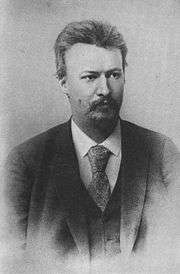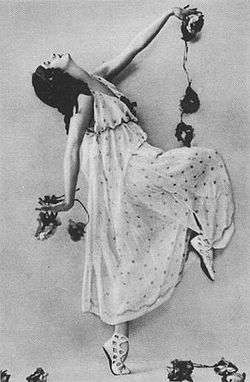The Seasons (ballet)
| Ballets and revivals of Marius Petipa |
|---|
*Paquita (1847, *1881) |
The Seasons (Russian: Времена года, Vremena goda; also French: Les saisons) is an allegorical ballet in one act, four scenes, by the choreographer Marius Petipa, with music by Alexander Glazunov, his Op. 67. The work was composed in 1899, and was first performed by the Imperial Ballet in 1900 in St. Petersburg, Russia.
History
Composition history
The score for Marius Petipa's Les Saisons (The Seasons) was originally intended to have been composed by the Italian composer and conductor Riccardo Drigo, who was Glazunov's colleague and close friend. Since 1886, Drigo held the posts of director of music and Chef d’orchestre to the Ballet of the St. Petersburg Imperial Theatres, while also serving as conductor for performances of the Italian operas in the repertory of the Imperial Opera. Petipa's Les Millions d’Arlequin (a.k.a. Harlequinade) was also in its preliminary stages at the same time as Les Saisons, and was originally intended to have had a score supplied by Glazunov. Since Drigo and Glazunov had an affinity towards each other's assigned ballet, the two composers agreed that Glazunov would compose Les Saisons and that Drigo would compose Les Millions d’Arlequin.
Petipa's Les Millions d'Arlequin was presented for the first time at the Imperial Theatre of the Hermitage on 23 February [O.S. 10 February] 1900. Les Saisons premiered three days later. For both performances the whole of the Imperial court was in attendance.
In 1907, Nikolai Legat staged a revival of Les Saisons at the Imperial Mariinsky Theatre. This production was performed on occasion by the Imperial Ballet after the Russian Revolution, being performed for the last time in 1927.
Les Saisons lived on in an abriged edition in the repertory of Anna Pavlova's touring company.

Performance history
St. Petersburg premiere (World Premiere)
- Date: 20 February [O.S. 7 February] 1900
- Place: Imperial Theatre of the Hermitage, Winter Palace, St. Petersburg
- Balletmaster: Marius Petipa
- Conductor: Riccardo Drigo
- Scene Designer: Pyotr Lambin
- Costume Designer: Yevgeni Ponomaryov
Other notable productions
- 1900, February 13, St. Petersburg, Imperial Mariinsky Theatre, same ensemble as the premiere
- 1907, St. Petersburg, Mariinsky Theatre, balletmaster Nikolay Legat, conducted by Drigo, décor by Lambin, costumes by Aleksandr Golovin.
Roles and original cast
| Role | St. Petersburg 1900 | St. Petersburg 1907 |
|---|---|---|
| Winter | Aleksey Bulgakov | Nikolay Solyannikov |
| Frost | Anna Pavlova | Agrippina Vaganova |
| Ice | Yuliya Sedova | E. Vill |
| Hail | Vera Trefilova | Lidiya Kyaksht |
| Snow | L. Petipa | Y. Ofitserova |
| Zephyr | Nikolay Legat | Mikhail Obukhov |
| Rose | Olga Preobrazhenskaya | Vera Trefilova |
| Swallow | Varvara Rïkhlyakova | Varvara Rïkhlyakova |
| Spirit of the Corn | Matilda Kshesinskaya | Olga Preobrazhenskaya |
| Faun | Mikhail Obukhov | Georgiy Kyaksht |
| Satyr | Aleksandr Gorsky | Leonid Leontyev |
| Satyr | Aleksandr Shiryayev | A. Matyatin |
| Bacchus | Pavel Gerdt | Samuil Andrianov |
| Bacchante | Marie Petipa | Anna Pavlova |
Publication history
- 1901, M.P. Belyayev, Leipzig
Instrumentation
Woodwinds: 1 piccolo, 2 flutes, 2 oboes (2nd doubling english horn in F), 2 clarinets in B-flat and A, 2 bassoons
Brass: 4 french horns in F, 2 trumpets in B-flat, 3 trombones, tuba
Percussion: timpani, triangle, tambourine, military drum, cymbal, bass drum, glockenspiel
Keyboard: celesta, pianino (upright piano)
Strings: harp, 1st and 2nd violins, violas, cellos, contrabass
Synopsis
Tableau 1 — A winter landscape
Winter is surrounded by his companions: Hoar-frost, Ice, Hail and Snow, who amuse themselves with a band of snowflakes. Two gnomes enter, and soon light a fire that causes all assembled to vanish.
Tableau 2 — A landscape covered with flowers
Spring dances with Zephyr, flower fairies, and enchanted birds. Upon feeling the heat of the sun, the assembly takes flight.
Tableau 3 — A landscape of flowing fields of wheat
Cornflowers and poppies revel in the light and warmth of the sun. They take rest after their exertion. Now Naiads appear, who bring water to refresh the growth, and the Spirit of Corn dances in thanksgiving. Satyrs and Fauns enter playing their pipes, and attempt to carry off the Spirit of the Corn, but she is rescued by the wind of Zephyr.
Tableau 4 — A landscape in Autumn
The Seasons take part in a glorious dance (the well-known "autumn bacchanale") while leaves from autumn trees rain upon their merriment.
Apotheosis — The Sable sky
Constellations of stars sparkle above the earth.
Résumé of dances and the mise-en-scène

St. Petersburg, 1907.
List of the numbers comprising The Seasons taken from the Yearbook of the Imperial Theatres, 1899-1900, being the original titles of the dances and mise en scène as originally staged.
- №01 Prélude
Tableau I — L’Hiver (winter)
- №02 Scène de l’Hiver
- №03 Variation du givre (frost)
- №04 Variation de la glace (ice)
- №05 Variation de la grêle (hail)
- №06 Variation de la neige (snow)
- №07 Coda
Tableau II — Le Printemps (spring)
- №08 Entrée de Printemps, Zéphyre, les Fées des fleurs, les oiseaux et les fleurs
Tableau III — L’Été (summer)
- №09 Scène de l’Été
- №10 Valse des bleuets et des pavots (Waltz of the Cornflowers and Poppies)
- №11 La Barcarolle – Entrée des naïades, le satyres et des faunes
- №12 Variation de l’Esprit du maïs
- №13 Coda
Tableau IV — L’Automne (fall)
- №14 Grande bacchanale des saisons—
- a. Entrée des saisons
- b. L’Hiver
- c. Le Printemps
- d. Bacchanale
- e. L’Été
- №15 Petit adage
- №16 Variation du Satyre
- №17 Coda générale
Apotheosis
- №18 Apothéose: La Révélation des étoiles
Discography
- 1929, Aleksandr Glazunov, unknown orchestra
- 1953, Roger Désormière, Orchestre National de France
- 1956, Albert Wolff, Paris Conservatoire Orchestra
- 1966, Ernest Ansermet, Suisse Romande Orchestra
- 196?, Konstantin Ivanov, USSR Symphony Orchestra
- 196?, Robert Irving, Concert Arts Orchestra
- 1978, Yevgeny Svetlanov, Philharmonia Orchestra
- 1987, Neeme Järvi, Scottish National Orchestra
- 1989, Vladimir Ashkenazy, Royal Philharmonic Orchestra
- 1993, Edo de Waart, Minnesota Orchestra
- 1987, Ondrej Lenard, Czecho-Slovak Radio Symphony Orchestra
Uses in popular culture
- Part of the Adagio from Autumn was chosen by Guy Mauffette as the musical theme for the long-running Radio-Canada soap opera Un homme et son péché (1939–1962) and its later adaptation for television, Les Belles Histoires des pays d'en haut (1956–1970).
- The Autumn Bacchanale is used as the introductory music to BBC TV's annual Richard Dimbleby Lectures (1972–).
- Excerpts from the ballet were heard on a recording featuring Don Wilson narrating the story of Ceres and Proserpina (here called Prosperine), with the music, played by the Continental Symphony Orchestra, serving as accompaniment. This recording was part of an LP issued by Capitol Records entitled Classics for Children.